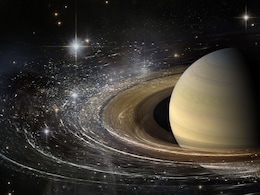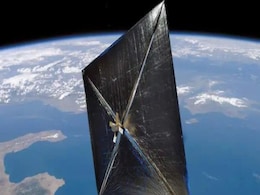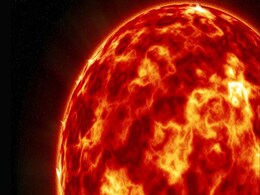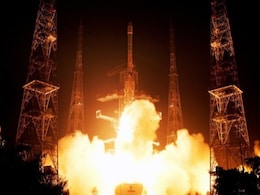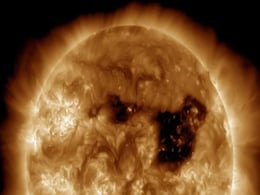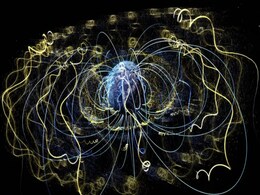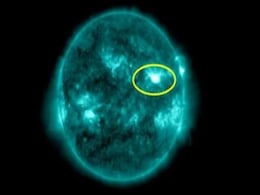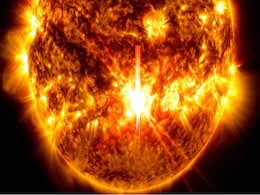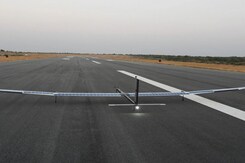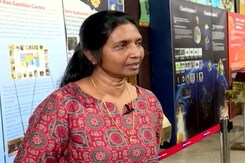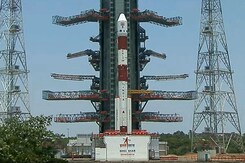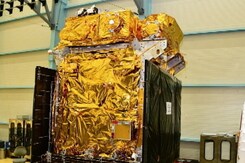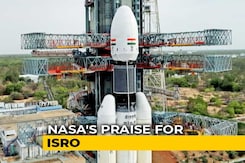Solar Satellite
- All
- News
- Videos
-

Two New Exoplanets Found Orbiting a Star in Draco Constellation
- Wednesday April 2, 2025
- Written by Gadgets 360 Staff
Astronomers have identified two exoplanets, TOI-1453 b and TOI-1453 c, orbiting a star 250 light-years away in Draco. The planets, a super-Earth and a sub-Neptune, were detected using NASA’s TESS satellite and the HARPS-N spectrograph. TOI-1453 b is a rocky planet orbiting close to its star, while TOI-1453 c is twice Earth’s size and may have a...
-
 www.gadgets360.com
www.gadgets360.com
-

Partial Solar Eclipse of March 2025: Satellite Images to Show Moon’s Shadow
- Saturday March 29, 2025
- Written by Gadgets 360 Staff
A partial solar eclipse will take place on March 29, 2025, visible across parts of Europe, Africa, and North America. The event will reach its peak in Nunavik, Canada, where 94% of the sun will be covered at sunrise. From space, weather satellites like GOES-16 and Himawari will capture images of the moon’s shadow. The International Space Station ...
-
 www.gadgets360.com
www.gadgets360.com
-

NASA’s EZIE Satellites Begin Mission to Study Auroral Electrojets and Space Weather
- Friday March 21, 2025
- Written by Gadgets 360 Staff
NASA’s Electrojet Zeeman Imaging Explorer (EZIE) mission has been launched aboard a SpaceX Falcon 9 from Vandenberg Space Force Base. The trio of small satellites will map auroral electrojets, powerful currents in Earth’s atmosphere linked to solar storms. Their data will enhance space weather prediction models and help understand planetary mag...
-
 www.gadgets360.com
www.gadgets360.com
-

Saturn Becomes Undisputed 'Moon King' Of Solar System With Discovery Of 128 New Satellites
- Monday March 17, 2025
- Science | Edited by Abhinav Singh
With the new spottings, Saturn has usurped Jupiter which has 95 known moons, while Uranus (28) and Neptune (16) remain third and fourth on the list.
-
 www.ndtv.com
www.ndtv.com
-

NASA Launches Satellite On Mission To Detect Water On The Moon
- Thursday February 27, 2025
- Science | Reuters
Lunar Trailblazer, which weighs about 440 pounds (200 kg) and measures about 11.5 feet (3.5 meters) wide when its solar panels are fully deployed, is being sent to find and map this water on the moon's surface.
-
 www.ndtv.com
www.ndtv.com
-

Solar Sail Satellites Could Enhance Space Weather Forecasting and Alerts
- Tuesday February 18, 2025
- Written by Gadgets 360 Staff
Solar sail satellites, harnessing sunlight for propulsion, are being developed to improve space weather forecasting. NOAA and NASA’s Solar Cruiser project aims to extend geomagnetic storm alert times by 50%, reducing risks to power grids, GPS, and air traffic. The new spacecraft, expected to launch in 2029, will move beyond traditional observatio...
-
 www.gadgets360.com
www.gadgets360.com
-

Tiny Plasma Jets on Sun Identified as Key Drivers of Solar Wind
- Friday February 14, 2025
- Written by Gadgets 360 Staff
Observations from ESA’s Solar Orbiter have revealed that tiny plasma jets, known as picoflares, are responsible for both the fast and slow components of the solar wind. The discovery challenges previous assumptions that different mechanisms drive these solar wind types. With further research, scientists hope to refine space weather predictions, p...
-
 www.gadgets360.com
www.gadgets360.com
-

May 2024 Solar Storm Triggers Unusual Radiation Belts, Raising Space Safety Concerns
- Wednesday February 12, 2025
- Written by Gadgets 360 Staff
A significant solar storm in May 2024 led to the creation of two temporary radiation belts, detected by the CIRBE satellite in June. One belt contained high-energy electrons, while the other was rich in protons, a rare occurrence. While the electron belt dissipated in three months, the proton-dominated belt remains, potentially affecting space miss...
-
 www.gadgets360.com
www.gadgets360.com
-

NASA’s PUNCH Mission Set to Track the Sun’s Corona and Solar Wind in 3D
- Friday February 7, 2025
- Written by Gadgets 360 Staff
NASA’s PUNCH mission, set for launch on Feb 27, will deploy four satellites to study the transition between the sun’s corona and the solar wind. The mission aims to improve understanding of space weather by capturing 3D images, helping predict solar storms with greater accuracy. The data will also complement NASA’s Parker Solar Probe, offerin...
-
 www.gadgets360.com
www.gadgets360.com
-

ISRO’s NVS-02 Satellite Stalls in Orbit Due to Technical Malfunction
- Tuesday February 4, 2025
- Written by Gadgets 360 Staff
A technical issue has stalled the orbit-raising operations of ISRO’s NVS-02 satellite, launched on January 29. While solar panels are functioning and communication is stable, the oxidizer valves have failed to open, preventing thruster activation. Tracking data indicates the satellite remains in its initial orbit. ISRO is assessing alternative wa...
-
 www.gadgets360.com
www.gadgets360.com
-

Massive Coronal Hole on Sun Sends High-Speed Solar Wind Toward Earth
- Tuesday February 4, 2025
- Written by Gadgets 360 Staff
A giant 800,000 km coronal hole on the Sun is unleashing high-speed solar wind toward Earth, potentially triggering a G1 geomagnetic storm on January 31 and February 1. The NOAA has issued a watch, predicting enhanced auroras in higher latitudes. While G1 storms are minor, they can impact satellites and power grids. The storm’s intensity remains ...
-
 www.gadgets360.com
www.gadgets360.com
-

Chorus Waves Found Far From Earth Raise Concerns for Space Exploration
- Tuesday January 28, 2025
- Written by Gadgets 360 Staff
Chorus waves, energetic electromagnetic bursts resembling bird chirps, have been detected 100,000 miles from Earth, far beyond their usual range. NASA's Magnetospheric Multiscale satellites observed these waves in a flatter region of Earth's magnetosphere, contradicting prior assumptions about their formation near strong magnetic gradients. The wav...
-
 www.gadgets360.com
www.gadgets360.com
-

NASA's LEXI Mission Will Explore Earth’s Magnetic Shield from the Moon
- Monday January 13, 2025
- Written by Gadgets 360 Staff
NASA is preparing for the launch of the Lunar Environment Heliospheric X-ray Imager (LEXI) aboard Firefly Aerospace's Blue Ghost lander, scheduled for January 15. The mission will observe Earth’s magnetosphere, capturing X-ray images that reveal how the planet's magnetic shield reacts to solar wind. This project could improve predictions of geoma...
-
 www.gadgets360.com
www.gadgets360.com
-

Massive Solar Flare Closes 2024 With Radio Blackouts and Auroral Possibilities
- Tuesday December 31, 2024
- Written by Gadgets 360 Staff
An X1.1-class solar flare on December 29, 2024, caused strong radio blackouts on Earth, marking another significant event in the increasingly active Solar Cycle 25. Detected by NOAA's GOES-16 satellite, the eruption raises questions about a potential coronal mass ejection, which could amplify auroras during New Year celebrations. While impactful, t...
-
 www.gadgets360.com
www.gadgets360.com
-

Solar Cycle 25: How the Sun’s Peak Activity Will Impact Earth in 2025
- Saturday December 28, 2024
- Written by Gadgets 360 Staff
Solar Cycle 25 continues with high activity levels in 2025. Increased solar flares and geomagnetic storms are anticipated, with risks to satellite systems and power grids. Widespread auroras could also light up low-latitude skies. Partial solar eclipses are scheduled for March and September in select regions. Observations indicate strong solar phen...
-
 www.gadgets360.com
www.gadgets360.com
-

Two New Exoplanets Found Orbiting a Star in Draco Constellation
- Wednesday April 2, 2025
- Written by Gadgets 360 Staff
Astronomers have identified two exoplanets, TOI-1453 b and TOI-1453 c, orbiting a star 250 light-years away in Draco. The planets, a super-Earth and a sub-Neptune, were detected using NASA’s TESS satellite and the HARPS-N spectrograph. TOI-1453 b is a rocky planet orbiting close to its star, while TOI-1453 c is twice Earth’s size and may have a...
-
 www.gadgets360.com
www.gadgets360.com
-

Partial Solar Eclipse of March 2025: Satellite Images to Show Moon’s Shadow
- Saturday March 29, 2025
- Written by Gadgets 360 Staff
A partial solar eclipse will take place on March 29, 2025, visible across parts of Europe, Africa, and North America. The event will reach its peak in Nunavik, Canada, where 94% of the sun will be covered at sunrise. From space, weather satellites like GOES-16 and Himawari will capture images of the moon’s shadow. The International Space Station ...
-
 www.gadgets360.com
www.gadgets360.com
-

NASA’s EZIE Satellites Begin Mission to Study Auroral Electrojets and Space Weather
- Friday March 21, 2025
- Written by Gadgets 360 Staff
NASA’s Electrojet Zeeman Imaging Explorer (EZIE) mission has been launched aboard a SpaceX Falcon 9 from Vandenberg Space Force Base. The trio of small satellites will map auroral electrojets, powerful currents in Earth’s atmosphere linked to solar storms. Their data will enhance space weather prediction models and help understand planetary mag...
-
 www.gadgets360.com
www.gadgets360.com
-

Saturn Becomes Undisputed 'Moon King' Of Solar System With Discovery Of 128 New Satellites
- Monday March 17, 2025
- Science | Edited by Abhinav Singh
With the new spottings, Saturn has usurped Jupiter which has 95 known moons, while Uranus (28) and Neptune (16) remain third and fourth on the list.
-
 www.ndtv.com
www.ndtv.com
-

NASA Launches Satellite On Mission To Detect Water On The Moon
- Thursday February 27, 2025
- Science | Reuters
Lunar Trailblazer, which weighs about 440 pounds (200 kg) and measures about 11.5 feet (3.5 meters) wide when its solar panels are fully deployed, is being sent to find and map this water on the moon's surface.
-
 www.ndtv.com
www.ndtv.com
-

Solar Sail Satellites Could Enhance Space Weather Forecasting and Alerts
- Tuesday February 18, 2025
- Written by Gadgets 360 Staff
Solar sail satellites, harnessing sunlight for propulsion, are being developed to improve space weather forecasting. NOAA and NASA’s Solar Cruiser project aims to extend geomagnetic storm alert times by 50%, reducing risks to power grids, GPS, and air traffic. The new spacecraft, expected to launch in 2029, will move beyond traditional observatio...
-
 www.gadgets360.com
www.gadgets360.com
-

Tiny Plasma Jets on Sun Identified as Key Drivers of Solar Wind
- Friday February 14, 2025
- Written by Gadgets 360 Staff
Observations from ESA’s Solar Orbiter have revealed that tiny plasma jets, known as picoflares, are responsible for both the fast and slow components of the solar wind. The discovery challenges previous assumptions that different mechanisms drive these solar wind types. With further research, scientists hope to refine space weather predictions, p...
-
 www.gadgets360.com
www.gadgets360.com
-

May 2024 Solar Storm Triggers Unusual Radiation Belts, Raising Space Safety Concerns
- Wednesday February 12, 2025
- Written by Gadgets 360 Staff
A significant solar storm in May 2024 led to the creation of two temporary radiation belts, detected by the CIRBE satellite in June. One belt contained high-energy electrons, while the other was rich in protons, a rare occurrence. While the electron belt dissipated in three months, the proton-dominated belt remains, potentially affecting space miss...
-
 www.gadgets360.com
www.gadgets360.com
-

NASA’s PUNCH Mission Set to Track the Sun’s Corona and Solar Wind in 3D
- Friday February 7, 2025
- Written by Gadgets 360 Staff
NASA’s PUNCH mission, set for launch on Feb 27, will deploy four satellites to study the transition between the sun’s corona and the solar wind. The mission aims to improve understanding of space weather by capturing 3D images, helping predict solar storms with greater accuracy. The data will also complement NASA’s Parker Solar Probe, offerin...
-
 www.gadgets360.com
www.gadgets360.com
-

ISRO’s NVS-02 Satellite Stalls in Orbit Due to Technical Malfunction
- Tuesday February 4, 2025
- Written by Gadgets 360 Staff
A technical issue has stalled the orbit-raising operations of ISRO’s NVS-02 satellite, launched on January 29. While solar panels are functioning and communication is stable, the oxidizer valves have failed to open, preventing thruster activation. Tracking data indicates the satellite remains in its initial orbit. ISRO is assessing alternative wa...
-
 www.gadgets360.com
www.gadgets360.com
-

Massive Coronal Hole on Sun Sends High-Speed Solar Wind Toward Earth
- Tuesday February 4, 2025
- Written by Gadgets 360 Staff
A giant 800,000 km coronal hole on the Sun is unleashing high-speed solar wind toward Earth, potentially triggering a G1 geomagnetic storm on January 31 and February 1. The NOAA has issued a watch, predicting enhanced auroras in higher latitudes. While G1 storms are minor, they can impact satellites and power grids. The storm’s intensity remains ...
-
 www.gadgets360.com
www.gadgets360.com
-

Chorus Waves Found Far From Earth Raise Concerns for Space Exploration
- Tuesday January 28, 2025
- Written by Gadgets 360 Staff
Chorus waves, energetic electromagnetic bursts resembling bird chirps, have been detected 100,000 miles from Earth, far beyond their usual range. NASA's Magnetospheric Multiscale satellites observed these waves in a flatter region of Earth's magnetosphere, contradicting prior assumptions about their formation near strong magnetic gradients. The wav...
-
 www.gadgets360.com
www.gadgets360.com
-

NASA's LEXI Mission Will Explore Earth’s Magnetic Shield from the Moon
- Monday January 13, 2025
- Written by Gadgets 360 Staff
NASA is preparing for the launch of the Lunar Environment Heliospheric X-ray Imager (LEXI) aboard Firefly Aerospace's Blue Ghost lander, scheduled for January 15. The mission will observe Earth’s magnetosphere, capturing X-ray images that reveal how the planet's magnetic shield reacts to solar wind. This project could improve predictions of geoma...
-
 www.gadgets360.com
www.gadgets360.com
-

Massive Solar Flare Closes 2024 With Radio Blackouts and Auroral Possibilities
- Tuesday December 31, 2024
- Written by Gadgets 360 Staff
An X1.1-class solar flare on December 29, 2024, caused strong radio blackouts on Earth, marking another significant event in the increasingly active Solar Cycle 25. Detected by NOAA's GOES-16 satellite, the eruption raises questions about a potential coronal mass ejection, which could amplify auroras during New Year celebrations. While impactful, t...
-
 www.gadgets360.com
www.gadgets360.com
-

Solar Cycle 25: How the Sun’s Peak Activity Will Impact Earth in 2025
- Saturday December 28, 2024
- Written by Gadgets 360 Staff
Solar Cycle 25 continues with high activity levels in 2025. Increased solar flares and geomagnetic storms are anticipated, with risks to satellite systems and power grids. Widespread auroras could also light up low-latitude skies. Partial solar eclipses are scheduled for March and September in select regions. Observations indicate strong solar phen...
-
 www.gadgets360.com
www.gadgets360.com




